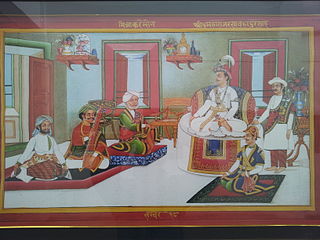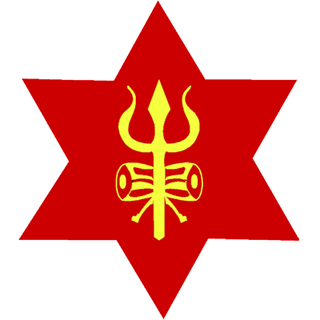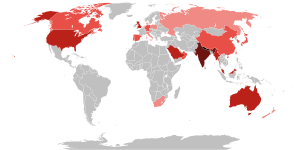Music of Nepal refers to the various musical genres played and listened to in Nepal. With more than fifty ethnic groups in Nepal, the country's music is highly diverse. Genres like Tamang Selo, Chyabrung, Dohori, Adhunik Geet, Bhajan, Filmi music, Ghazal, Classical music, songs and Ratna music are widely played and popular, but many other less common genres are yet to be cataloged. Western musical genres like Rock, Metal, Hip-Hop, Rap, R&B also regularly feature on the Nepalese music charts. Most of the country's musical bands are based in the Kathmandu valley. Musical genres from Tibet and India have greatly influenced Nepalese music.

The Magar, also spelled Mangar and Mongar, are Magar language speaking ethnolinguistic group native to Nepal, representing 6.9% of Nepal's total population according to the 2021 Nepal census. They are one of the main Gurkha tribes.

Biratnagar is a metropolitan city in Nepal, which serves as the capital of Koshi Province. With a Metropolitan Urban Agglomeration population of 244,750 as per the 2021 census, it is the largest city and fastest growing city in the province and also the headquarters of Morang district. As per the preliminary report of 2022 Nepal census, Biratnagar Metropolitan has an estimated city population of 243,927 excluding the suburban areas which are now very well connected to the old town. It is the administrative center of the Greater Birat Development Area which incorporates the cities of Biratnagar and its suburbs and towns of-Itahari-Gothgau-Biratchowk-Dharan primarily located on the Koshi Highway in Eastern Nepal, with an estimated total urban agglomerated population of 804,300 people in 159,332 households including the town of Ithari. Biratnagar is located 399 km (248 mi) east of the capital, Kathmandu, and 6 km (3.7 mi) north of the bordering town of Jogbani in the Indian state of Bihar. It is one of the major entry point in Nepal for Businessmen as well as Tourists who come to visit Nepal for various purposes.

The Shah dynasty, also known as the Shahs of Gorkha or the Royal House of Gorkha, was the ruling Chaubise Thakuri dynasty and the founder of the Gorkha Kingdom from 1559 to 1768 and later the unified Kingdom of Nepal from 1768 to 28 May 2008.

Thapa (pronunciation:) is a Nepali surname belonging to the Magar Civilisation of Nepal. They are indigenous people of Nepal It is also used by the Chhetri community group in Nepal.

Nepali are the citizens of Nepal under the provisions of Nepali nationality law. The term Nepali usually refers to the nationality, that is, to people with citizenship of Nepal, while the people without Nepales citizenship but with roots in Nepal such as Nepali Americans are strictly referred to as Nepali Speaking Foreigners who are speakers of Nepali, Maithili or any of the other 128 Nepali languages but are now foreign citizens or of foreign nationality bearing passports and citizenship of the foreign nation. It is also not generally used to refer to non-citizen residents, dual citizens, and expatriates.

The Nepali Army, also referred as the Gorkhali Army, is the land service branch of the Nepali Armed Forces. After the Gorkha Kingdom was founded in 1559, its army was established in 1560, and was accordingly known as the Gorkhali Army. The army later became known as the Royal Nepali Army (RNA) following the Unification of Nepal, when the Gorkha Kingdom expanded its territory to include the whole country, by conquering and annexing the other states in the region, resulting in the establishment of a single united Hindu monarchy over all of Nepal. It was officially renamed simply to the Nepali Army on 28 May 2008, upon the abolition of the 240-year-old Nepalese monarchy, and of the 449-year-old rule of the Shah dynasty, shortly after the Nepalese Civil War.
The Non Resident Nepali Association is an association of Non Resident Nepalis (NRN).
The community of Nepalis in China consists of Nepalese immigrants and expatriates to China as well as Chinese citizens of Nepalese descent.

Rekha Thapa is a Nepalese actress and politician. She won the CG Digital Film Awards for Best Actress, and in 2011 she also won the NEFTA Film Awards for Best Actress.
Lamichhane is a surname found in Nepal. Used by Bahun, Chhetri, Magar and Gurung, the name originates from Lamachhini village in west central Nepal.They belong to different clans such as Aatreya,Garga etc. They are sacred thread bearers (Tagadhari), twice-born Hindus and trace their origins to Indo-Aryan people.They are connected with the Thapa dynasty of the Nepal.
The National Film Awards is the most prominent and prestigious award of Nepali cinema. The first National Film Award was held in 2005, in the presence of His Majesty's King Gyanendra Bir Bikram Shah. The event is held at the residence of the president of Nepal and the president gives the awards to the winners in various categories. It is yearly organised by Film Development Board, Nepal.

Samragyee Rajya Laxmi Shah, credited as Samragyee RL Shah, is a Nepali film actress who works in Nepali cinema. Shah is the recipient of several awards, including one NFDC National Film Awards and one NEFTA Film Awards.
"Melancholy" is an environmentally-themed song sung by 365 Nepali artists. This song was intended to promote an environmental message by breaking the Guinness World Records for "Most Vocal Solos in a Song Recording", which it successfully did. It was written, music composed and directed by environmentalist Nipesh Dhaka. The song was recorded as a single on 19 May 2016. The recording sessions were inaugurated by Prime Minister Khadga Prasad Oli at 8 am and continued until 6 pm. The song was released on 2 September 2017 by President Bidya Devi Bhandari at Army Officer's Club, Kathmandu.

Bhuwan Chand is a Nepali actress. She is known for Aama, the first Nepali feature film which was produced in 1964. Owing to her lead role in the first feature film produced in Nepal, which was produced by the Nepal government, she is known as the first actress of Nepal. Her other works include Hijo, Aaja, Bholi (1967), Manko Baandh (1973), Sindoor (1980), Jivan Rekha, Ke ghar ke dera (1987), Pachchis Basanta (1988) and Santideep (1989) among others.










